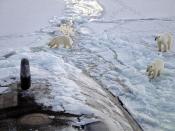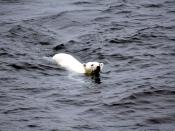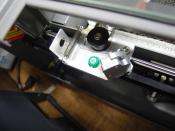The region's climate is very harsh, and often includes incredibly cold winters. However, the summers can be quite pleasant. The image of the North being a land of constant snow and ice is a completely incorrect. Temperatures become mild during the summer months. The average temperature for areas near Yellowknife in July is 16ú C. However, the annual average temperature in Alert is -18ú C, in Inuvik -10 ú C, and in Resolute, -17ú C.
The North is engulfed in permafrost or tundra. This makes agriculture nearly impossible to develop. Houses must be built up on stands because of unstable soils, caused by the thawing of permafrost. This thawing can cause sinking in the ground surface which is another reason houses must be built up. In the southern areas of the North, permafrost may actually thaw completely during the summertime.
Along with the permafrost, there are icecaps, glaciers, pingos, which are huge mounds of solid ice, and the polar ice pack, which is permanently frozen sea ice.
Due to the tilt of the Earth's Axis, there are 6 months of continual darkness, and then 6 months of continual light during the summer.
Vegetation in this region is very scarce. The various types of vegetation found in the North include Cotton Grass in the low arctic, patchy vegetation in the mid arctic; however the arctic poppy seems to like these settings. Very sparse vegetation occurs in the high arctic, yet Saxifrage and arctic willows proceed to flourish there. Pretty much, the rest of the landscape includes lichen and rock. Very few trees can survive up North, due to its very cold climate. In fact, this region is located above the tree line, which means it is nearly impossible for trees to reside so far north.
There is a huge amount of...


